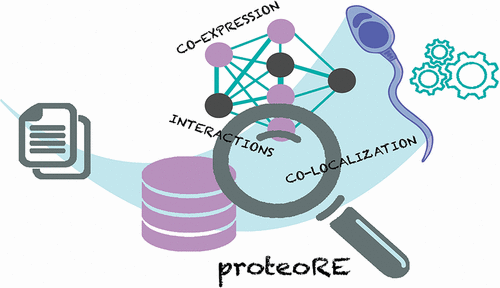当前位置:
X-MOL 学术
›
J. Proteome Res.
›
论文详情
Our official English website, www.x-mol.net, welcomes your feedback! (Note: you will need to create a separate account there.)
The Functionally Unannotated Proteome of Human Male Tissues: A Shared Resource to Uncover New Protein Functions Associated with Reproductive Biology
Journal of Proteome Research ( IF 4.4 ) Pub Date : 2020-10-16 , DOI: 10.1021/acs.jproteome.0c00516 Yves Vandenbrouck 1 , Charles Pineau 2 , Lydie Lane 3
Journal of Proteome Research ( IF 4.4 ) Pub Date : 2020-10-16 , DOI: 10.1021/acs.jproteome.0c00516 Yves Vandenbrouck 1 , Charles Pineau 2 , Lydie Lane 3
Affiliation

|
In the context of the Human Proteome Project, we built an inventory of 412 functionally unannotated human proteins for which experimental evidence at the protein level exists (uPE1) and which are highly expressed in tissues involved in human male reproduction. We implemented a strategy combining literature mining, bioinformatics tools to collate annotation and experimental information from specific molecular public resources, and efficient visualization tools to put these unknown proteins into their biological context (protein complexes, tissue and subcellular location, expression pattern). The gathered knowledge allowed pinpointing five uPE1 for which a function has recently been proposed and which should be updated in protein knowledge bases. Furthermore, this bioinformatics strategy allowed to build new functional hypotheses for five other uPE1s in link with phenotypic traits that are specific to male reproductive function such as ciliogenesis/flagellum formation in germ cells (CCDC112 and TEX9), chromatin remodeling (C3orf62) and spermatozoon maturation (CCDC183). We also discussed the enigmatic case of MAGEB proteins, a poorly documented cancer/testis antigen subtype. Tools used and computational outputs produced during this study are freely accessible via ProteoRE (http://www.proteore.org), a Galaxy-based instance, for reuse purposes. We propose these five uPE1s should be investigated in priority by expert laboratories and hope that this inventory and shared resources will stimulate the interest of the community of reproductive biology.
中文翻译:

人类男性组织的功能未注释的蛋白质组:共享资源来发现与生殖生物学相关的新蛋白质功能。
在人类蛋白质组计划的背景下,我们建立了412种未注释功能的人类蛋白质的清单,这些蛋白质存在蛋白质水平的实验证据(uPE1),并在参与人类雄性生殖的组织中高度表达。我们实施了一项结合文献挖掘,生物信息学工具以整理来自特定分子公共资源的注释和实验信息以及有效的可视化工具的策略,以将这些未知蛋白质置于其生物学环境中(蛋白质复合物,组织和亚细胞位置,表达模式)。所收集的知识可以查明五个最近被提出功能的uPE1,应该在蛋白质知识库中对其进行更新。此外,这种生物信息学策略允许针对其他五种uPE1建立新的功能假说,这些假说与男性生殖功能特有的表型特征相关,例如生殖细胞中的睫毛发生/鞭毛形成(CCDC112和TEX9),染色质重塑(C3orf62)和精子成熟(CCDC183) )。我们还讨论了MAGEB蛋白的神秘案例,MAGEB蛋白是文献/文献报道很少的癌症/睾丸抗原亚型。可以通过ProteoRE(http://www.proteore.org)(基于Galaxy的实例)免费访问此研究过程中使用的工具和产生的计算结果,以供重用。我们建议应由专家实验室对这五个uPE1进行优先研究,并希望这种库存和共享资源将激发生殖生物学界的兴趣。
更新日期:2020-12-04
中文翻译:

人类男性组织的功能未注释的蛋白质组:共享资源来发现与生殖生物学相关的新蛋白质功能。
在人类蛋白质组计划的背景下,我们建立了412种未注释功能的人类蛋白质的清单,这些蛋白质存在蛋白质水平的实验证据(uPE1),并在参与人类雄性生殖的组织中高度表达。我们实施了一项结合文献挖掘,生物信息学工具以整理来自特定分子公共资源的注释和实验信息以及有效的可视化工具的策略,以将这些未知蛋白质置于其生物学环境中(蛋白质复合物,组织和亚细胞位置,表达模式)。所收集的知识可以查明五个最近被提出功能的uPE1,应该在蛋白质知识库中对其进行更新。此外,这种生物信息学策略允许针对其他五种uPE1建立新的功能假说,这些假说与男性生殖功能特有的表型特征相关,例如生殖细胞中的睫毛发生/鞭毛形成(CCDC112和TEX9),染色质重塑(C3orf62)和精子成熟(CCDC183) )。我们还讨论了MAGEB蛋白的神秘案例,MAGEB蛋白是文献/文献报道很少的癌症/睾丸抗原亚型。可以通过ProteoRE(http://www.proteore.org)(基于Galaxy的实例)免费访问此研究过程中使用的工具和产生的计算结果,以供重用。我们建议应由专家实验室对这五个uPE1进行优先研究,并希望这种库存和共享资源将激发生殖生物学界的兴趣。



























 京公网安备 11010802027423号
京公网安备 11010802027423号